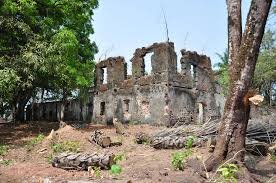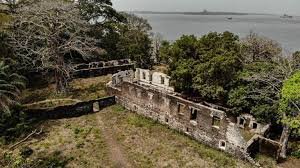Bunce Island, a small, uninhabited island in the Sierra Leone River, served as a major slave trading post in West Africa from the late 1600s to 1807, where British traders shipped tens of thousands of enslaved Africans to the Americas. Bunce Island is located in the Sierra Leone River, about 20 miles (32 kilometers) upriver from Freetown, the capital of Sierra Leone.
Bunce Island (also spelled “Bence,” “Bense,” or “Bance” at different periods) is an island in the Sierra Leone River. It is situated in Freetown Harbour, the estuary of the Rokel River and Port Loko Creek, about 20 miles (32 kilometres) upriver from Sierra Leone’s capital city Freetown. The island measures about 1,650 feet (502.9 metres) by 350 feet (106.7 metres) and houses a castle that was built by the Royal Africa Company in c.1670. Tens of thousands of Africans were shipped from here to the North American colonies of South Carolina and Georgia to be forced into slavery, and are the ancestors of many African Americans of the United States.

It was a fortified British trading post and a pass-over point for commercial ships transporting enslaved people to the West Indies and North America. The Royal African Company established a commercial fort on Bunce Island around 1670. The island was a major slave trading operation from the late 1600s to 1807, when the British government outlawed the slave trade. From Bunce Island, enslaved people were sold to colonies in the West Indies and North America, with a significant number going to the rice plantations in South Carolina and Georgia.
Although the island is small, its strategic position at the limit of navigation for ocean-going ships in Africa’s largest natural harbour made it an ideal base for European slave traders. To mark the 2007–2008 bicentennial of Britain’s abolition of the slave trade, a team at James Madison University created a three-dimensional animation of the castle as it was in 1805, and an exhibit on the site that was displayed to museums all across the U.S. which is now held by the Sierra Leone National Museum.
Bunce Island was first settled and fortified by English slave traders circa 1670. During its early history, the castle was operated by two London-based firms: the Royal African Company and its offshoot, the Gambia Adventurers, the latter a “Crown-chartered company” or parastatal subsidized by the Crown. On October 31, 1678, at Gresham College the latter offered the former the contents of their investment on the island. The castle was not commercially successful but it served as a symbol of English influence in the region, where Portuguese slave traders had been established since the 1500s.
The island is now uninhabited, with the ruins of the slave trading buildings serving as a somber reminder of its history. Bunce Island was one of the most lucrative slave trading operations in West Africa
The early phase of the castle’s history ended in 1728 when Bunce Island was raided by José Lopez da Moura, a Luso-African slave trader based in the area. He was the richest man in present-day territory of Sierra Leone, the grandson of a Mane king and part of the hybrid Luso-African community that had developed along the lower rivers. This class acted as middlemen, resisting efforts by the Royal African Company to monopolize trade with African rulers. Lopez led others in destroying the Bunce Island factory.
It was at the limit of navigability for ocean-going vessels, making it a natural meeting place for European slave traders and African traders.

Studies have revealed connections between the linguistic traits and cultural traditions of the Gullah people in Georgia and South Carolina and the people of Sierra Leone, highlighting the impact of Bunce Island on the transatlantic slave trade. Bunce Island is included on UNESCO’s Tentative List for World Heritage status nomination. The island is marked by rapidly deteriorating ruins, wrapped in a somber air.
There are ongoing efforts to conserve what’s left of the island and to build a museum in Freetown to shed light on its dark past. The Bunce Island Coalition has launched a project to conserve the island and build a museum in Freetown.
Bunce Island was abandoned until the mid-1740s. It was later operated by the London-based firm Grant, Oswald & Company, founded by Scottish merchants Richard Oswald and Alexander Grant, who took over in 1748.
The History of Bunce Island
In 1785 Bunce and a number of other dependent islands were conveyed to the company of John and Alexander Anderson. Throughout the late 18th century, it was a highly profitable enterprise. During the second half of the eighteenth century, the companies sent thousands of slaves from Bunce Island to plantations on the British and French colonies in the West Indies, and to Britain’s North American colonies.
Bance Island House, the headquarters building where the Chief Agent lived with his senior officers, was at the centre of the castle. Immediately behind it was the open-air slave yard, which was divided between a large area for men and a smaller one for women and children. Remnants of two watchtowers, a fortification with places for eight cannons, and a gunpowder magazine remain standing. Some of the cannons bear the royal cypher of King George III. At the south end of the island, several inscribed tombstones mark the graves of slave traders, slave ship captains, and the foreman of African workers.
The slave traders who did business at Bunce Island came from a variety of backgrounds. During the castle’s early history, Afro-Portuguese—part of what historian Ira Berlin described as the “Atlantic Creole generation”—sold slaves and local products there. They were well-established along the rivers near the coast and were descendants of male Portuguese slave traders known as lançados and African women, and were often bilingual. During the island’s later history, Afro-English dynasties became established in communities along the West African coast, beginning in the 17th century. By 1800, there were about 12,000 Afro-English in this area. Mixed-race men from such families as the Caulkers, Tuckers and Clevelands sold slaves and traded goods at Bunce Island. Like the Portuguese descendants, they occupied a middle ground, often marrying into the upper classes of African tribes. The slave ships came from London, Liverpool and Bristol; from Newport, Rhode Island in the North American colonies; and from France and Denmark. They transported slaves mostly to European colonies in the Caribbean and the American South.
Bunce Island was an important British commercial outpost and an attractive target during times of war. French naval forces attacked the castle four times (1695, 1704, 1779, and 1794), damaging or destroying it each time. The attack of 1779 took place during the American War of Independence when the Continental Army’s French allies took advantage of the conflict to attack British assets outside North America. Pirates, including Bartholomew Roberts or “Black Bart”, the most notorious pirate of the 18th century, attacked in 1719 and 1720. The British traders rebuilt the castle after each attack, gradually altering its architecture during the roughly 140 years it was used as a slave trade entrepôt.

Bunce Island is best known as one of the chief processing points for slaves to be sold to planters in Lowcountry of the British colonies of South Carolina and Georgia, including the Sea Islands, where they developed extensive rice plantations. Rice requires a great deal of technical knowledge for its successful cultivation. South Carolinan and Georgian planters were willing to pay premium prices for slave labour brought from what they called the “Rice Coast” of West Africa, the traditional rice-growing region stretching from what is now Senegal and Gambia in the north down to present-day Sierra Leone and Liberia in the south. Still, records of the port of Charleston show that nearly 40 percent of the slaves came from Angola.
Stay tuned for the continuation of this article on Bunce Island…here on our website www.globalafricantimes.com




